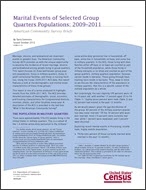Marital Events of Selected Group Quarters Populations: 2009-2011
Marital Events of Selected Group Quarters Populations: 2009-2011
Marriage, divorce, and widowhood are important events in people’s lives. The American Community Survey (ACS) provides us with the unique opportunity to examine the incidence of recent marriage, divorce, and widowhood among people living in group quarters. This report focuses on three well-known group quarters populations: those in military quarters, those in adult correctional facilities, and those in nursing facilities. Using the 3-year 2009-2011 ACS data, this report features a look at the demographic and marital event characteristics of these three groups.1
This report is one of a series produced to highlight results from the 2009-2011 ACS. The ACS provides detailed estimates of demographic, social, economic, and housing characteristics for Congressional districts, counties, places, and other localities every year. A description of the ACS is provided in the text box “What Is the American Community Survey?”
__________
1 For further details about group quarters, see the ”Group Quarters” section starting on p. 8 of the ACS subject definitions at <www2.census.gov/programs-surveys/acs/tech_docs/subject_definitions/2010_ACSSubjectDefinitions.pdf>. For further details about the various types of group quarters, refer to <www2.census.gov/programs-surveys/acs/tech_docs/group_definitions/2010GQ_Definitions.pdf>.
Others in Series
Publication
Publication
Publication




